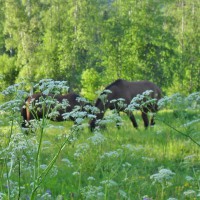Vitamin E and A in forage for horses

Vitamins are essential organic compounds and they exist in small amounts in natural feeds. They are divided into fat soluble vitamins A, D, E and K and water soluble vitamins B and C. Horses’ vitamin requirements vary with age, performance and stress situation. When horses are on pasture they have no need for supplementation of vitamins. Maintenance fed horses and horses doing light to medium hard work have no, or very small, needs for supplementation of vitamins if they are given a diet based on good forage and daily get to spend time outside.
When vitamin A and E are added to feed it is often in synthetic form since that is easier and cheaper to produce than adding natural α-tocopherol and vitamin A. However, several studies have shown that there are advantages with adding the natural form of α-tocopherol since the synthetic have less effect than the natural. Good forage is the greatest source of natural vitamins and can often cover the horse’s vitamin A and E requirements. But forage content of α-tocopherol and ß-carotene (pro-vitamin A) can vary a lot depending on where it is grown, plant species, harvest date, climate, conservation method etc.
Plants are photosynthetic organisms and they produce α-tocopherol and ß-carotene which are antioxidants and their function is largely to protect plant and animal cells from oxidation and harmful products from the oxidation process. Forages grown in the south of Sweden often have higher vitamin content than forages grown in the north of Sweden. This can be due to several factors such as differences in growth rate, temperature and sun light. But it can also be due to that the forages were harvested at different growth stages and which plants were included in the seed mixture. Plants with higher leaf proportion often have higher vitamin content than plants with less proportion of leaves since the largest amounts of α-tocopherol and ß-carotene in plants are found in the leaves. The stress sensitivity of plants also affects their α-tocopherol and ß-carotene content.
Harvest date and growth stage have effects on the vitamin content of forage, some claim that the vitamin content is highest in young plants in the vegetative stage while others claim that the vitamin content in plants increase up until the plant starts to bloom and then decreases. It is difficult to draw conclusions since there are many factors contributing and it is also difficult to find a “winner” among grass species as the variation in vitamin content of forage seems to be greater between harvests and locations than grass species. However birdsfoot trefoil had higher vitamin content than clover in most of Lindqvist’s studies.
Silages often contain considerable more vitamins than for example hay. Factors that can affect the vitamin loss in forage are weather conditions during wilting and the forage’s storage time. Ensiling method and additives can also have an impact on the vitamin content; in Lindqvist’s studies the use of a bacterial inoculant in red clover mixtures had positive effect on the content of vitamin E during ensiling compared to untreated red clover silage. However an acidic additive decreased the vitamin E content during ensiling of the red clover mixtures, whilst it increased the vitamin E content in the birdsfoot trefoil mixture. Lindqvist found the positive effect of ensiling and bacterial inoculant remarkable and more studies needs to be carried out to determine why silage treated with bacterial inoculant gave the forage higher content of α-tocopherol.
Sara Muhonen, AgrD
